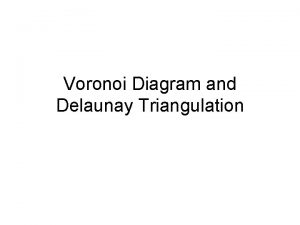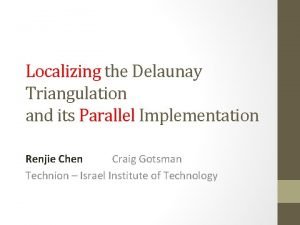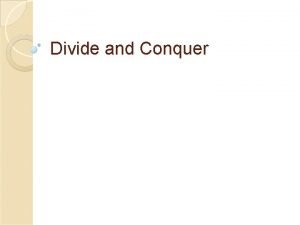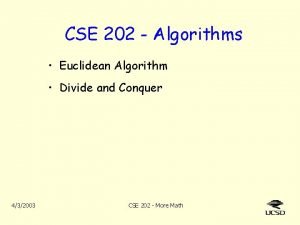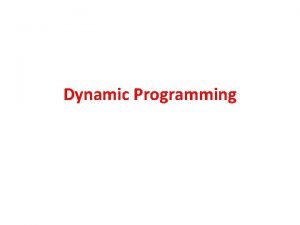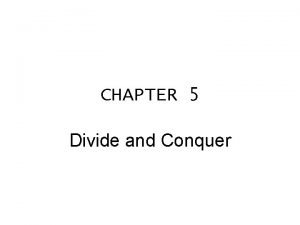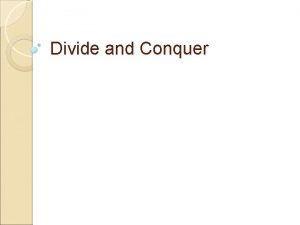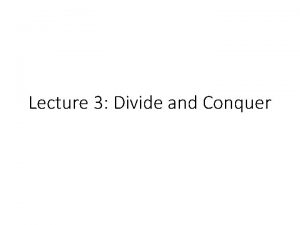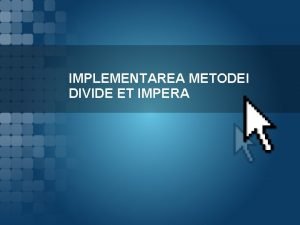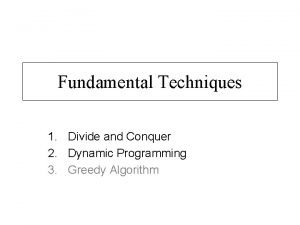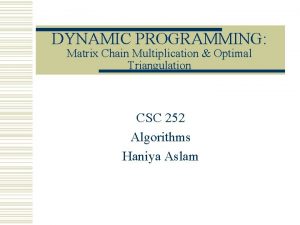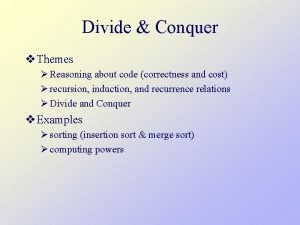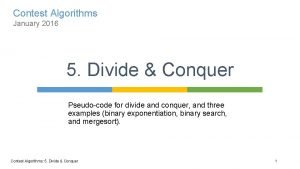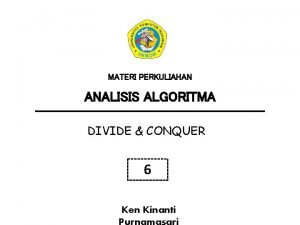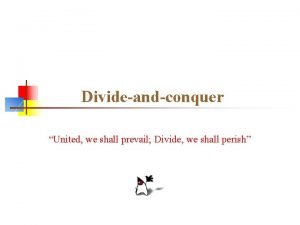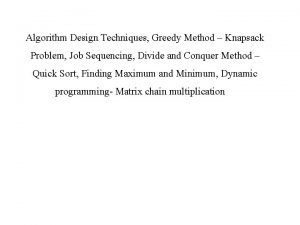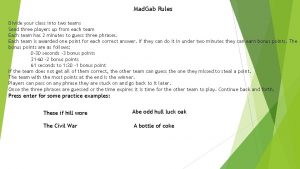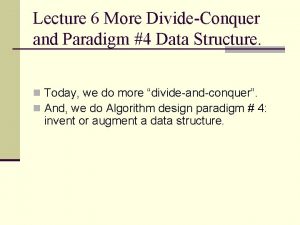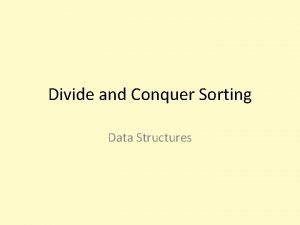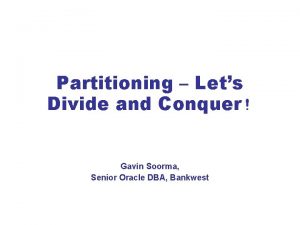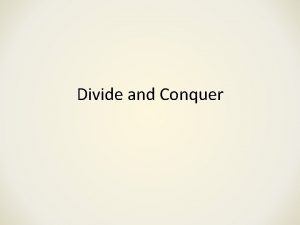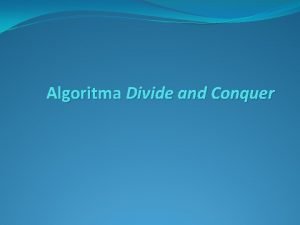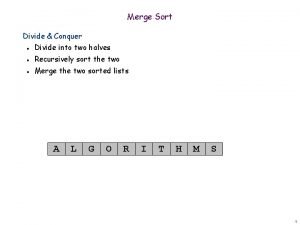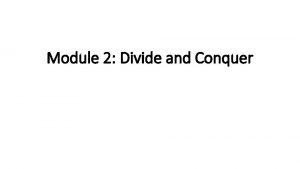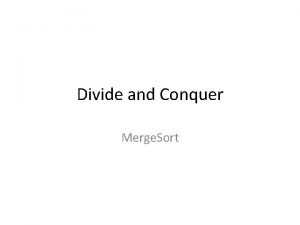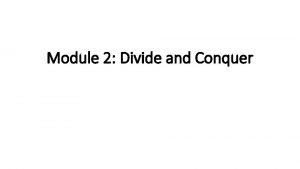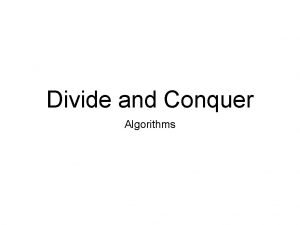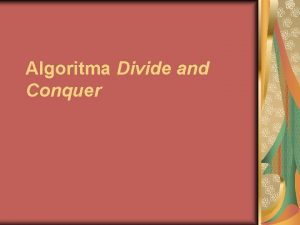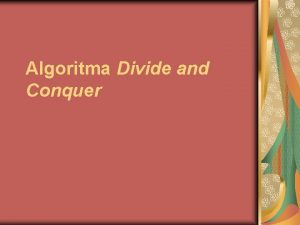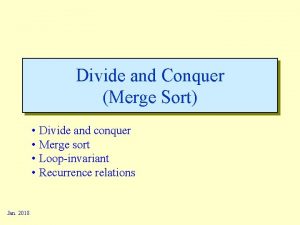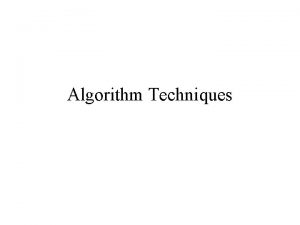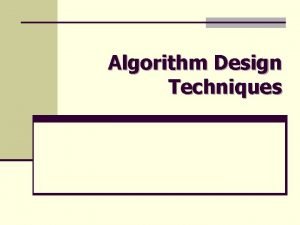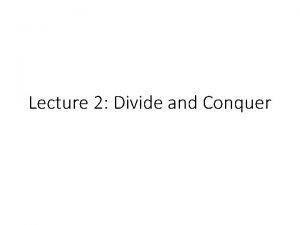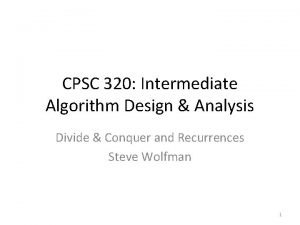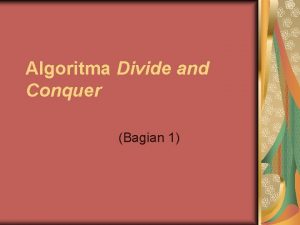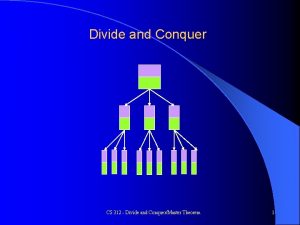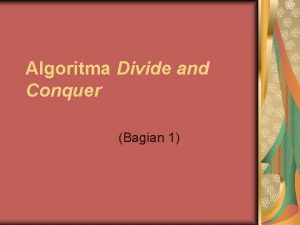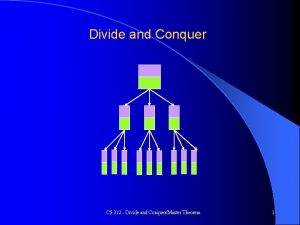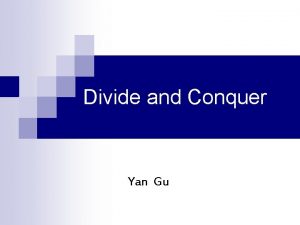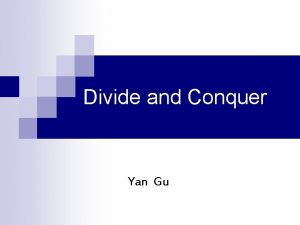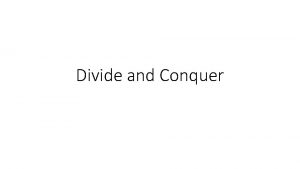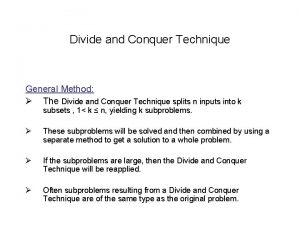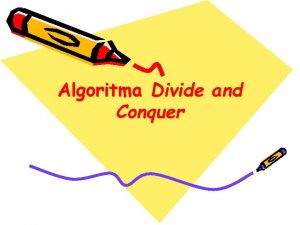Algorithm Design Techniques Divide and Conquer Introduction Divide

























- Slides: 25

Algorithm Design Techniques: Divide and Conquer

Introduction • Divide and conquer – algorithm makes at least two recursive calls • Subproblems should not be overlapping – Example: Fibonacci numbers • Examples – Recursive maximum subsequence sum – Linear time tree traversal – Mergesort, quicksort

Running Time • Mergesort – T(N) = 2 T(N/2) + O(N) • Theorem: The solution to the equation T(N) = a. T(N/b) + θ(Nk) where a>=1 and b>1, is T(N) = O(Nlog ba) a > bk = O(Nklog. N) a = bk = O(Nk) a < bk

Running Time: Proof • Let – N=bm N/b=bm-1 Nk=(bm)k=bmk=bkm=(bk)m • T(1) = 1 • T(bm) = a. T(bm-1)+(bk)m - divide by a m k/a)i • T(bm)/am = Σ(b i=0 • multiply by am m and use telescoping

Running Time: Proof m • T(bm) = ami=0 Σ(bk/a)i • a > bk – series will converge to a constant – T(N) = O(am) = O(alog b. N) = O(Nlog ba) • a = bk – each term in sum is 1, sum contains 1+logb. N terms, logba = k – T(N) = O(amlogb. N) = O(Nlog balogb. N) = O(Nklog. N) • a < bk – each term will be greater than 1 – T(N) = am(((bk/a)m+1 -1)/((bk/a)-1)) = O(am(bk/a)m) = O((bk)m) = O(Nk)

Running Time • Theorem: If a 1+ a 2+. . . + ak < 1, then the solution to the equation T(N) = T(a 1 N) + T(a 2 N) +. . . + T(ak. N) +O(N) is T(N) = O(N) • Idea: problem is made smaller at every step

Closest-Points Problem • p 1 = (x 1, y 1) p 2 = (x 2, y 2) • Euclidean distance between p 1 and p 2 is [(x 1 -x 2)2 + (y 1 -y 2)2]1/2 • Goal: Given N points, find closest pair • Brute force algorithm?

Closest-Points Example

Closest-Points Problem • Brute force algorithm? – O(N 2) • Divide and Conquer – similar to maximum subsequence sum sort by X coordinate find closest two in left half (d. L) find closest two in right half (d. R) find closest two where 1 is in left, 1 in right (d. C) closest is minimum

Closest-Points Example d. C d. R d. L

Closest-Points Problem find closest two where 1 is in left, 1 in right (d. C) • To ensure O(Nlog. N) solution, this step must be done in O(N) time – d = min(d. L, d. R) – Only need to look at points d from center – Still cannot do brute force on these points – what would be running time? – Observe: for each point, only need to consider points that are less than d away in y coordinate – There a maximum of 7 points to consider • Points must be separated by at least d • Don't need to look at points that have already been processed

Example: Worst Case

Algorithm: find. Closest T(N) = Nlog. N + 2 T(N/2) + 7 N (inner loop runs max 7 times) preprocessing step 1: sort by x coordinate preprocessing step 1: sort by y coordinate find. Closest(left) find. Closest(right) for(i=0; i<num. Points. In. Strip; i++) for(j=i+1; j<num. Points. In. Strip; j++) if(y coordinates of pi and pj differ by more than d) break; else if(dist(pi, pj) < d) d = dist(pi, pj)

Selection Problem • Find kth smallest element in a collection of N elements • Obvious algorithm? – Sort, find kth – running time? • Can be solved in O(N)

Selection Problem • Quickselect – partition (as in quicksort) into S 1 and S 2 • if k < size of S 1 – quickselect on S 1 • else if k == size of S 1 + 1 – found • else quickselect on S 2 • Running time could still be N 2 unless pivot is guaranteed to be chosen wisely

Selection Problem • Choosing the pivot – Arrange N elements into floor(N/5) groups of 5 elements – Find median of each group. This gives a list M of floor(N/5) medians. • Sort each set (8 operations) – Find median of M. Choose as pivot • Call quickselect(M/2) on M elements

Example S – small Medians L – large H – huge T – tiny T T T T T S S S L L v L S L H H H H H

Pivot Selection • • 10 k+5 = N 2 k+1 medians 1 pivot, k L's, and K S's 2 k+2 H's, and 2 k+2 T's 3 k+2 larger than pivot 3 k+2 smaller than pivot (10 k+5)-(3 k+2)-1(pivot) = max 7 k+2 in partition <. 7 N

Running Time: Quickselect • partition into N/5 arrays of size 5 and sort • find median of medians (quickselect) – use as pivot • partition • if pivot is kth element – return • else quickselect on appropriate partition T(N) = 8(N/5) + T(. 2 N) + N + T(. 7 N) = O(N)

Multiplying Integers • • x = 61, 438, 521 y = 94, 736, 407 Typical algorithm is N 2 Use divide and conquer! XL=6, 143 XR=8, 521 YL=9, 473 YR=6, 407 X = XL 104+XR Y = YL 104+YR XY = XLYL 108 + (XLYR + XRYL)104 + XRYR T(N) = 4 T(N/2) + O(N) = O(N 2)

Multiplying Integers • XY = XLYL 108 + (XLYR + XRYL)104 + XRYR • X LY R + X RY L = (XL – XR)(YR-YL)+XLYL+XRYR • Use 1 multiplication plus 2 results already computed • T(N) = 3 T(N/2) + O(N) • T(N) = O(Nlog 23) = O(N 1. 59)

Matrix Multiplication A=3416 1257 5129 4356 B=5693 4531 1184 3141 Ci, j = dot product of ith row of A and jth col of B C 0, 0 = (3*5)+(4*4)+(1*1)+(6*3) Brute force algorithm = O(N 3)

Matrix Multiplication A 1, 1 A 1, 2 A 2, 1 A 2, 2 B 1, 1 B 1, 2 B 2, 1 B 2, 2 = C 1, 1 = A 1, 1 B 1, 1 + A 1, 2 B 2, 1 C 1, 2 = A 1, 1 B 1, 2 + A 1, 2 B 2, 2 C 2, 1 = A 2, 1 B 1, 1 + A 2, 2 B 2, 1 C 2, 2 = A 2, 1 B 1, 2 + A 2, 2 B 2, 2 C 1, 1 C 1, 2 C 2, 1 C 2, 2

Matrix Multiplication • T(N) = 8 T(N/2) + O(N 2) – additions take N 2 • Still O(N 3) M 1 = (A 1, 2 - A 2, 2) (B 2, 1+ B 2, 2) M 2 = (A 1, 1+A 2, 2) (B 1, 1+ B 2, 2) M 3 = (A 1, 1 - A 2, 1) (B 1, 1+ B 1, 2) M 4 = (A 1, 1+ A 1, 2) (B 2, 2) M 5 = (A 1, 1) (B 1, 2 -B 2, 2) M 6 = (A 2, 2) (B 2, 1 -B 1, 1) M 7 = (A 2, 1+ A 2, 2) (B 1, 1)

Matrix Multiplication C 1, 1 = M 1 + M 2 – M 4 + M 6 C 1, 2 = M 4 + M 5 C 2, 1 = M 6 + M 7 C 2, 2 = M 2 - M 3 + M 5 - M 7 T(N) = 7 T(N/2) + O(N 2) = O(Nlog 27) = O(N 2. 81)
 Voronoi diagram
Voronoi diagram Delaunay triangulation divide and conquer algorithm
Delaunay triangulation divide and conquer algorithm Tromino tiling problem
Tromino tiling problem Is euclidean algorithm divide and conquer
Is euclidean algorithm divide and conquer Dynamic programming vs divide and conquer
Dynamic programming vs divide and conquer Divide and conquer algorithm
Divide and conquer algorithm Skyline problem divide and conquer
Skyline problem divide and conquer Divide and conquer advantages and disadvantages
Divide and conquer advantages and disadvantages Counting inversions divide and conquer
Counting inversions divide and conquer Suma elementelor pare divide et impera
Suma elementelor pare divide et impera Dynamic programming bottom up
Dynamic programming bottom up Dynamic programming vs divide and conquer
Dynamic programming vs divide and conquer Prove correctness of divide and conquer
Prove correctness of divide and conquer Divide and conquer pseudocode
Divide and conquer pseudocode The expression is a
The expression is a Divide and conquer
Divide and conquer Divide should ideas prevail
Divide should ideas prevail Divide and conquer algoritma
Divide and conquer algoritma Knapsack problem divide and conquer
Knapsack problem divide and conquer Mad gab rules
Mad gab rules Powering a number divide and conquer
Powering a number divide and conquer Insertion sort divide and conquer
Insertion sort divide and conquer Partitioning
Partitioning Divide and conquer complexity
Divide and conquer complexity Algorithm couple
Algorithm couple Divide and conquer
Divide and conquer
